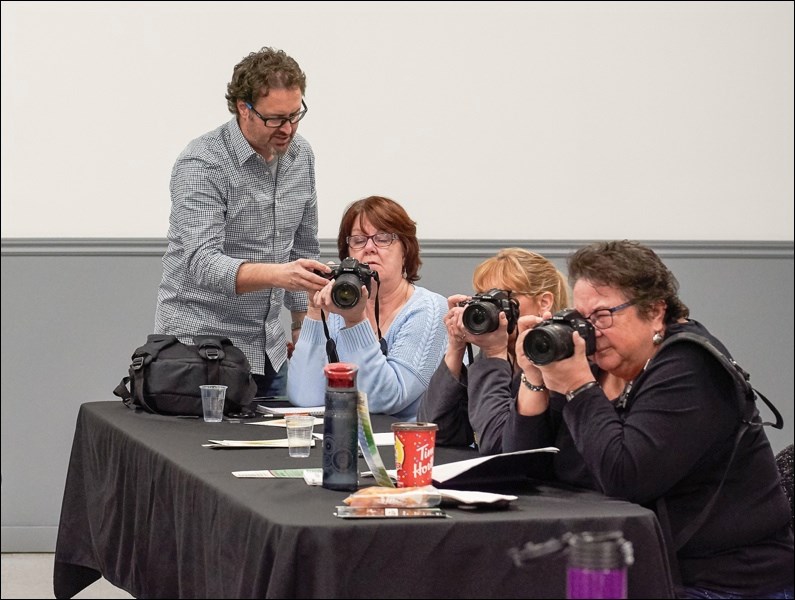You may not realize it with all the snow on the ground, but storm chasing season is fast approaching for the “Tornado Hunter” Greg Johnson.
“We’re not that far away now, this cold weather’s finally leaving,” said Johnson, who is looking to launch his annual storm-chasing activities for 2019 in a few weeks.
Until then, Johnson is staying active with public appearances and photo clinics across the country.
His latest was a photo workshop held Thursday and Friday at the Western Development Museum in North Battleford, teaching aspiring photographers every aspect of their cameras.
Johnson’s workshop focused on “teaching people how to use a digital camera and get shots that are beyond the point-shoot-snapshot stage,” he said.
He shared his secrets on how to get the top-quality shots.
“The magic of photography really happens when you use the camera in manual mode,” said Johnson. “When it comes to actually creating artwork, when it comes to really getting creative with photography, you need to understand how the camera works. And that’s what this workshop is about, is understanding how the camera works and how to get the result you’re looking for.”
His workshops included instructing the participants on the finer points such as shutter speed, aperture, and ISO (image sensitivity).
Johnson admits all those terms can be intimidating for people. He likens it to being inside the cockpit of an airplane, surrounded by gadgets, buttons and dials.
“The camera’s sort of the same way,” said Johnson. “Once you can sort of eliminate all the distracting stuff that you put on these cameras, and break it down to its most simple parts, photography can actually become a very enjoyable hobby for a lot of people.”
These photo workshops are something Johnson regularly holds in North Battleford. He says he normally gets up to the city once a year.
Later on Thursday, Johnson put on a presentation at Chapel Gallery for the Battlefords Photo Club focusing on his storm-chasing and photography efforts. His visit was sponsored by Northwest Community Futures.
Johnson’s visit to North Battleford took place right after a major outbreak of tornadoes in Alabama, Georgia and Florida on March 3 that killed upwards of 23 people. Central Alabama was particularly hard-hit.
While the timing of those storms might take people by surprise, Johnson said March is when tornado season typically starts up in those southeastern states.
“Every time spring rolls around, it seems that tornadoes start making it into the news again,” said Johnson.
“And every time a small town gets hit, you know, I think our memories are kind of short. We sort of forget that that happens every year.”
While the timing of the outbreak in Alabama was not unusual for this time of year, “what was unusual was how violent the storms were,” said Johnson. “There were a couple of EF-4 tornadoes that did a lot of damage.”
EF-4s are tornadoes that within 10 or 15 seconds “will wipe a house off of its foundation. So it’s certainly not something to be taking lightly and so this time of year is when you talk about storm safety and what do you do.”
The Alabama tornadoes had been the first EF-4 or “violent” tornadoes in a while. EF-5 is the highest rating.
“In fact, 2018 was the first year ever recorded where there were no violent tornadoes in the United States,” said Johnson.
But Canada saw two violent tornadoes last year – one in August in Alonsa, Man., and the other in the greater Ottawa area in September that caused considerable damage.
Notably, they happened in “really out-of-tornado-season times, which is really unusual,” said Johnson. The beginning of August is usually when tornado season is ending. But that wasn’t the case last year, Johnson said.
The Alonsa tornado was the only EF-4 in North America last year, pointing to weather patterns changing, he said, but he emphasized springtime is still the prime season.
While tornado season usually begins around this time of year in the southeastern U.S., Johnson says he doesn’t start chasing until mid to late April when the storms move into the plains states of Kansas, Oklahoma and Texas. The reason? Personal safety. Johnson said the southeast is heavily treed with lots of hills, making tornadoes difficult to see.
It is out on the plains where you can photograph the “high visibility, photogenic, supercell based tornadoes and you can remain relatively safe and still get a decent perspective.”
By late May, tornado season normally moves up to Nebraska and by early June into the Dakotas and Minnesota. It’s around July that the season is at its peak around Saskatchewan.
Johnson expects he and his team, which includes videographer Chris Chittick and Ricky Forbes, who drives their bright-orange “Tornado Hunters” vehicle, will be out storm-chasing in late April, continuing into the middle of July.
On occasions, the crew will take on guests who will be signing up as passengers on the chase. Those guests will come from as far away as the United Kingdom, Germany and Dubai of the United Arab Emirates.
The big question is whether they will see some good tornadoes when they arrive. For his part, Johnson is optimistic about an active season. He believes storm activity could pick up this year, due in part to the “El Nino” that was responsible for some cold conditions on the prairies over the winter, and some extreme conditions elsewhere in North America.
For that reason, Johnson expects a lot of troughing of the jet stream in the spring, and that’s what brings the tornadoes, he said.
He sees a similar pattern to 2011 and 2012, which brought active storm seasons.
“If I were a betting man, I would expect it would be a fairly active season,” said Johnson. “If I was farming, I would definitely be making sure I was in on the hail insurance this year.”
But if nothing happens, he said, “Don’t blame me, OK, because it’s still weather!”



